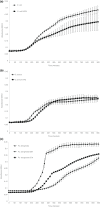Priming with biocides: A pathway to antibiotic resistance?
- PMID: 35384175
- PMCID: PMC9543593
- DOI: 10.1111/jam.15564
Priming with biocides: A pathway to antibiotic resistance?
Abstract
Aims: To investigate the priming effects of sub-inhibitory concentrations of biocides on antibiotic resistance in bacteria.
Methods and results: Escherichia coli, Pseudomonas aeruginosa and Staphylococcus aureus were exposed to sub-inhibitory concentrations of biocides via a gradient plate method. Minimum inhibitory concentration (MIC) and antibiotic susceptibility were determined, and efflux pump inhibitors (thioridazine and chlorpromazine) were used to investigate antibiotic resistance mechanism(s). Escherichia coli displayed a twofold increase in MIC (32-64 mg l-1 ) to H2 O2 which was stable after 15 passages, but lost after 6 weeks, and P. aeruginosa displayed a twofold increase in MIC (64-128 mg l-1 ) to BZK which was also stable for 15 passages. There were no other tolerances observed to biocides in E. coli, P. aeruginosa or S. aureus; however, stable cross-resistance to antibiotics was observed in the absence of a stable increased tolerance to biocides. Sixfold increases in MIC to cephalothin and fourfold to ceftriaxone and ampicillin were observed in hydrogen peroxide primed E. coli. Chlorhexidine primed S. aureus showed a fourfold increase in MIC to oxacillin, and glutaraldehyde-primed P. aeruginosa showed fourfold (sulphatriad) and eightfold (ciprofloxacin) increases in MIC. Thioridazine increased the susceptibility of E. coli to cephalothin and cefoxitin by fourfold and twofold, respectively, and both thioridazine and chlorpromazine increased the susceptibility S. aureus to oxacillin by eightfold and fourfold, respectively.
Conclusions: These findings demonstrate that sub-inhibitory concentrations of biocides can prime bacteria to become resistant to antibiotics even in the absence of stable biocide tolerance and suggests activation of efflux mechanisms may be a contributory factor.
Significance and impact of the study: This study demonstrates the effects of low-level exposure of biocides (priming) on antibiotic resistance even in the absence of obvious increased biocidal tolerance.
© 2022 The Authors. Journal of Applied Microbiology published by John Wiley & Sons Ltd on behalf of Society for Applied Microbiology.
Conflict of interest statement
None declared.
Figures
Similar articles
-
Growth media and assay plate material can impact on the effectiveness of cationic biocides and antibiotics against different bacterial species.Lett Appl Microbiol. 2018 May;66(5):368-377. doi: 10.1111/lam.12863. Epub 2018 Mar 22. Lett Appl Microbiol. 2018. PMID: 29432643
-
Nosocomial Escherichia coli, Klebsiella pneumoniae, Pseudomonas aeruginosa, and Staphylococcus aureus: Sensitivity to Chlorhexidine-Based Biocides and Prevalence of Efflux Pump Genes.Int J Mol Sci. 2025 Jan 3;26(1):355. doi: 10.3390/ijms26010355. Int J Mol Sci. 2025. PMID: 39796210 Free PMC article.
-
Comparative analysis of antibiotic and antimicrobial biocide susceptibility data in clinical isolates of methicillin-sensitive Staphylococcus aureus, methicillin-resistant Staphylococcus aureus and Pseudomonas aeruginosa between 1989 and 2000.J Appl Microbiol. 2004;97(4):699-711. doi: 10.1111/j.1365-2672.2004.02345.x. J Appl Microbiol. 2004. PMID: 15357719
-
Bacterial resistance to disinfectants: present knowledge and future problems.J Hosp Infect. 1999 Dec;43 Suppl:S57-68. doi: 10.1016/s0195-6701(99)90066-x. J Hosp Infect. 1999. PMID: 10658759 Review.
-
Efflux-mediated tolerance to cationic biocides, a cause for concern?Microbiology (Reading). 2022 Nov;168(11). doi: 10.1099/mic.0.001263. Microbiology (Reading). 2022. PMID: 36748532 Review.
Cited by
-
Biofilms as protective cocoons against biocides: from bacterial adaptation to One Health issues.Microbiology (Reading). 2023 Jun;169(6):001340. doi: 10.1099/mic.0.001340. Microbiology (Reading). 2023. PMID: 37266984 Free PMC article. Review.
-
Tolerance of Pseudomonas oleovorans biofilms to disinfectants commonly used in endoscope reprocessing?Biofilm. 2024 Sep 25;8:100221. doi: 10.1016/j.bioflm.2024.100221. eCollection 2024 Dec. Biofilm. 2024. PMID: 39430297 Free PMC article.
-
Biocide Susceptibility and Antimicrobial Resistance of Escherichia coli Isolated from Swine Feces, Pork Meat and Humans in Germany.Antibiotics (Basel). 2023 Apr 27;12(5):823. doi: 10.3390/antibiotics12050823. Antibiotics (Basel). 2023. PMID: 37237726 Free PMC article.
-
Antiseptic management of critical wounds: differential bacterial response upon exposure to antiseptics and first insights into antiseptic/phage interactions.Int J Surg. 2024 Sep 1;110(9):5374-5384. doi: 10.1097/JS9.0000000000001605. Int J Surg. 2024. PMID: 38742847 Free PMC article.
-
Domestic laundering of healthcare textiles: Disinfection efficacy and risks of antibiotic resistance transmission.PLoS One. 2025 Apr 30;20(4):e0321467. doi: 10.1371/journal.pone.0321467. eCollection 2025. PLoS One. 2025. PMID: 40305442 Free PMC article.
References
-
- Amaral, L. , Kristiansen, J. & Lorian, V. (1992) Synergic effect of chlorpromazine on the activity of some antibiotics. J Antimicrob Chemother, 4, 556–558. - PubMed
-
- Bock, L. , Wand, M. & Sutton, J. (2016) Varying activity of chlorhexidine‐based disinfectants against Klebsiella pneumoniae clinical isolates and adapted strains. J Hosp Infect, 93, 42–48. - PubMed
MeSH terms
Substances
LinkOut - more resources
Full Text Sources
Molecular Biology Databases
Research Materials


